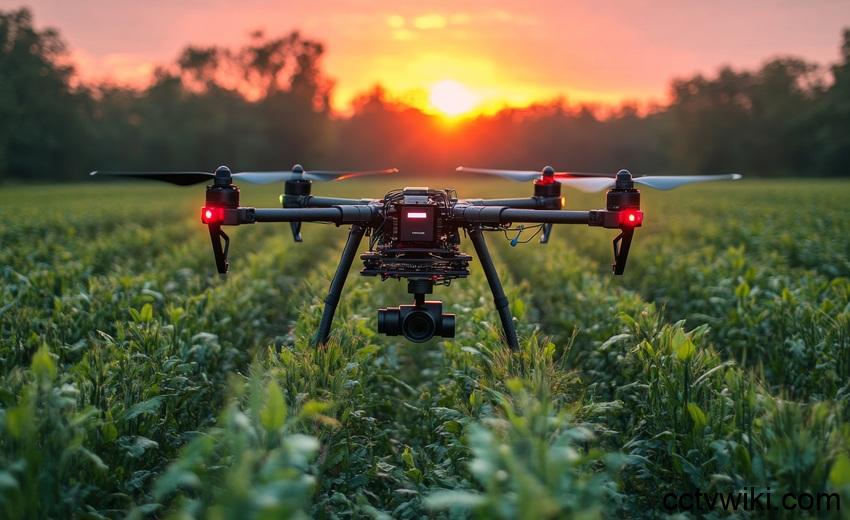AI Takes Flight: How Artificial Intelligence is Revolutionizing Commercial Drones
Artificial intelligence (AI) has landed in nearly every industry, and the commercial drone sector is no exception. These aren’t your average hobby drones; we’re talking about sophisticated machines equipped with cameras, sensors, and even delivery modules. The infusion of AI has transformed these aerial devices into powerhouses capable of tackling complex tasks with remarkable precision.
Unlocking New Drone Applications with AI
One of the biggest game-changers is the enhanced autonomy AI brings to the table. AI-powered drones can now embark on missions without constant human oversight, thanks to advanced algorithms that handle navigation, obstacle avoidance, and on-the-fly decision-making. This newfound independence allows drones to venture into challenging environments, like disaster zones or remote areas, where sending humans would be too risky or simply impractical.
AI has also supercharged the data processing capabilities of commercial drones. Armed with AI-driven sensors and cameras, these drones can capture and analyze massive amounts of data in real-time. This is a game-changer for industries like agriculture, where drones can monitor crop health, assess soil conditions, and fine-tune resource usage, leading to greater efficiency and higher yields.
In the world of logistics, AI-powered drones are rewriting the rules of delivery. Companies are using AI to optimize flight paths, ensuring timely and cost-effective deliveries. This not only slashes operational costs but also shrinks their environmental footprint, as drones can be programmed to take the most efficient routes, minimizing energy consumption.
AEBU IMM/Consumer, Micron Technology
AI is also bolstering security and safety. AI-driven drones can identify and track suspicious activities, sending real-time alerts to security personnel. Their ability to operate discreetly and cover vast areas makes them invaluable assets for maintaining safety and security in diverse settings, from crowded public events to critical infrastructure sites.
The marriage of AI and commercial drones is also opening up exciting new possibilities in environmental monitoring and conservation. AI-powered drones can monitor wildlife populations, track endangered species, and assess the health of ecosystems with minimal disruption to natural habitats. This technology provides researchers and conservationists with crucial data, helping them protect our planet’s biodiversity.
As AI continues to evolve, its impact on commercial drones will only grow, unlocking even more innovative applications. The synergy between AI and drone technology promises to drive innovation, efficiency, and sustainability across a wide range of industries, shaping the future of how we interact with the world from above.
Implications of AI Integration on Memory and Storage in Drone Systems
As drones evolve from remotely piloted vehicles into autonomous, intelligent systems, the integration of AI is fundamentally changing their hardware architecture, particularly in terms of memory and storage. AI-powered drones are now expected to handle complex tasks like real-time object detection, facial recognition, terrain mapping, and autonomous navigation. These demands require a complete rethinking of how memory and storage are provisioned and optimized, all while staying within strict size, weight, and power (SWaP) constraints.
1. Memory Requirements for AI Inference at the Edge
AI models running on drones, such as convolutional neural networks (CNNs) for image classification or YOLO (you only look once) for object detection, need significant memory bandwidth and low-latency access. Typically, LPDDR4 or LPDDR5 DRAM is used to support real-time inference workloads. The memory must handle:
* The AI model weights (often hundreds of MBs)
* Intermediate feature maps during inference
* Sensor data buffers (e.g., video frames from cameras or LiDAR)
For instance, a drone processing a 1080p video stream at 30 fps for real-time object detection might need 1–2GB of DRAM just for buffering and inference. If multiple models are running simultaneously (e.g., for multi-object tracking or semantic segmentation), memory requirements can jump to 4GB or more.
2. Storage Demands for Data Logging and Model Hosting
Storage in AI-powered drones serves two main purposes: persistent storage of AI models and logging mission-critical data. NAND flash-based storage (e.g., eMMC, UFS, NVMe SSDs, or memory cards) is typically used because of its durability and compact size.
Key storage considerations include:
* **Model storage:** AI models can range from 50MB (e.g., MobileNet) to several hundred MBs (e.g., ResNet, YOLOv5). Multiple models may be stored for different mission profiles.
* **Sensor data logging:** High-resolution video, telemetry, and environmental data are often logged for post-mission analysis or compliance. A 4K video stream at 30 fps can consume up to 1GB per minute, depending on compression and quality settings, necessitating high-capacity storage (64GB to 1TB).
* **Endurance:** Continuous write operations from video and sensor logging require industrial-grade NAND with high endurance to prevent premature failure.
3. AI at the Edge Versus Cloud Offloading
While cloud-based AI processing can reduce the need for on-device compute and storage, drones often operate in areas with limited or no connectivity. This forces the need for edge AI processing, which in turn increases the demand for high-speed memory and local storage. Hybrid architectures, where lightweight inference is done onboard and heavier analytics are offloaded when connectivity is available, are becoming increasingly common.
4. Thermal and Power Constraints
Memory and storage components must also meet strict thermal and power budgets. LPDDR5 offers higher bandwidth at lower power, making it suitable for AI workloads. Similarly, low-power mNAND with thermal throttling protection is preferred to maintain performance without overheating.
Meeting the Challenge with Proven Solutions
As AI-driven drones push the boundaries of what’s possible at the edge, the demands on memory and storage systems are growing exponentially. Meeting these challenges requires not only high-performance components but also solutions that are rugged, efficient, and scalable. That’s where Micron’s industrial-grade memory and storage portfolio comes into play—purpose-built to support the evolving needs of intelligent, autonomous systems operating in demanding environments.
Micron Industrial Memory and Storage Solutions – Key Highlights
Micron offers a robust portfolio of industrial-grade memory and storage solutions designed to meet the rigorous demands of edge computing, automation, and mission-critical applications. With decades of experience in the industrial market, Micron’s products are engineered for reliability, longevity, and performance in harsh environments.
The lineup includes high-speed DRAM (such as LPDDR5X and DDR5), durable NAND flash storage (e.MMC, UFS, NVMe SSDs, and memory cards), and compact multichip packages (MCPs) that integrate memory and storage into a single footprint. These components are optimized for wide temperature ranges, shock and vibration resistance, and low power consumption—making them excellent for industrial IoT, transportation, video security, and robotics applications, as well as AI-powered commercial drones that require compact, rugged, and efficient memory solutions for real-time processing and analytics.
Micron also leads in innovation with products like the i400 industrial microSD card, the world’s first 1.5 TB card designed for AI-enhanced video at the edge. Its compact form factor and high capacity make it an excellent lightweight solution for drones, enabling continuous high-resolution recording and analytics in space-constrained systems.
With a commitment to quality, extended product lifecycles, and ecosystem collaboration, Micron’s industrial solutions empower next-generation intelligent systems to operate reliably and efficiently at the edge.
In summary, AI integration in drones demands high-performance, efficient, and durable hardware. Selecting the right memory and storage architecture is essential to unlocking the full potential of intelligent, autonomous drones operating at the edge. Micron is a trusted advisor in this market and can help you select the memory and storage for your next design.
*Joey Lin is Senior Segment Marketing Manager AEBU IMM/Consumer at Micron*

